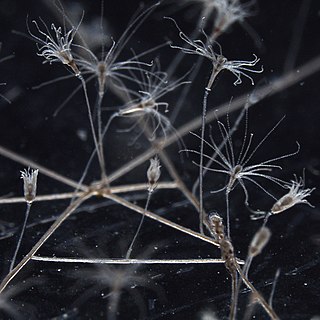
The Antarctic Circumpolar Current (ACC) is an ocean current that flows clockwise from west to east around Antarctica. An alternative name for the ACC is the West Wind Drift. The ACC is the dominant circulation feature of the Southern Ocean and has a mean transport estimated at 100–150 Sverdrups, or possibly even higher, making it the largest ocean current. The current is circumpolar due to the lack of any landmass connecting with Antarctica and this keeps warm ocean waters away from Antarctica, enabling that continent to maintain its huge ice sheet.

The climate of Antarctica is the coldest on Earth. The continent is also extremely dry, averaging 166 mm (6.5 in) of precipitation per year. Snow rarely melts on most parts of the continent, and, after being compressed, becomes the glacier ice that makes up the ice sheet. Weather fronts rarely penetrate far into the continent, because of the katabatic winds. Most of Antarctica has an ice-cap climate with extremely cold and dry weather.

Diel vertical migration (DVM), also known as diurnal vertical migration, is a pattern of movement used by some organisms, such as copepods, living in the ocean and in lakes. The word "diel" comes from Latin: diēs, lit. 'day', and means a 24-hour period. The migration occurs when organisms move up to the uppermost layer of the sea at night and return to the bottom of the daylight zone of the oceans or to the dense, bottom layer of lakes during the day. It is important to the functioning of deep-sea food webs and the biologically driven sequestration of carbon.

The Weddell Gyre is one of the two gyres that exist within the Southern Ocean. The gyre is formed by interactions between the Antarctic Circumpolar Current (ACC) and the Antarctic Continental Shelf. The gyre is located in the Weddell Sea, and rotates clockwise. South of the ACC and spreading northeast from the Antarctic Peninsula, the gyre is an extended large cyclone. Where the northeastern end ends at 30°E, which is marked by the southward turn of the ACC, the northern part of the gyre spreads over the Southern Scotia Sea and goes northward to the South Sandwich Arc. Axis of the gyre is over the southern flanks of the South Scotia, America-Antarctic, and Southwest Indian Ridges. In the southern part of the gyre, the westward return flow is about 66 sverdrup (Sv), while in the northern rim current, there is an eastward flow of 61 Sv.

The West Australian Current is a cool surface current of the Southern Ocean and Southern Indian Ocean.
Karen Frances Wishner is an American oceanographer currently at University of Rhode Island and an elected fellow of the American Association for the Advancement of Science. Her interests include coastal shelf and zooplankton behavior and environment, and has published her findings.
Calanus helgolandicus is a copepod found in the Atlantic, from the North Sea south to the western coast of Africa. The female has an average size of about 2.9 millimetres (0.11 in) and the male has an average size of about 2.7 millimetres (0.11 in).
Calanus pacificus is a species of copepod found in the Pacific Ocean. The female has an average length of about 3.1 millimetres (0.12 in), and the male has a value of about 2.9 millimetres (0.11 in).
Calanus propinquus is a copepod found in Antarctica, and the surrounding waters.

Calanoides acutus is a copepod found in Antarctica and the surrounding waters.
Metridia longa is a copepod found in the Arctic, the north Atlantic, the Pacific, and surrounding waters. The female has an average length of about 4.2 millimetres (0.17 in), and the males have an average length of about 3.5 millimetres (0.14 in).
Neocalanus plumchrus is a large species of copepod found in the Pacific and Arctic Oceans. It was described in 1921 H. by Marukawa. N. flemingeri was formerly considered as conspecific, likely as a form, until it was split in 1988 by Charles B. Miller.
Neocalanus cristatus is a species of copepod found primarily in the northern Pacific.
Pseudocalanus newmani is a copepod found in Arctic and northern Pacific waters. It was described by Frost in 1989. It is found in the Arctic and surrounding waters. There are multiple generations. Unlike some copepods, P. newmani undergoes reverse diel vertical migration, descending during the night, and ascending during the day, although it may undergo normal or no migration at all depending on predation. This copepod is primarily herbivorous.
Calanus sinicus is a copepod found in the northwest Pacific.
Rhincalanus nasutus is a copepod in the family Rhincalanidae.

Metridia gerlachei is a copepod found primarily in Antarctic and sub-Antarctic waters.
A metachronal swimming or metachronal rowing is the swimming technique used by animals with multiple pairs of swimming legs. In this technique, appendages are sequentially stroked in a back-to-front wave moving along the animal’s body. In literature, while metachronal rhythm or metachronal wave usually refer to the movement of cilia; metachronal coordination, metachronal beating, metachronal swimming or metachronal rowing usually refer to the leg movement of arthropods, such as mantis shrimp, copepods, antarctic krill etc. though all of them refer to the similar locomotion pattern.

Rosalindidae is a family of cnidarians belonging to the order Anthoathecata.
Carin Jessica Ashjian is an American biological oceanographer who is an associate scientist at the Woods Hole Oceanographic Institution. She studies how the physical environment influences the distribution of plankton in the Beaufort Sea.







